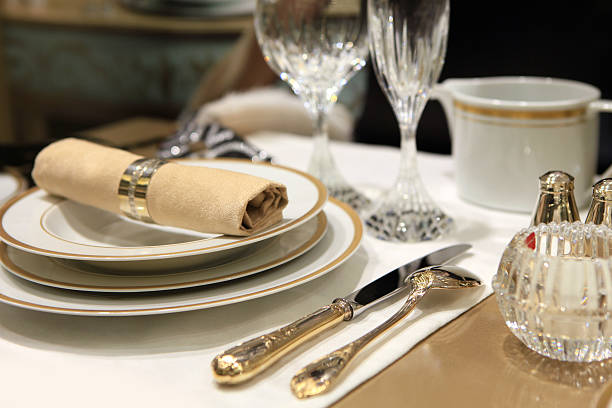Before we dive into the particulars, let’s clear the table (pun intended) and define dining etiquette. Etiquette is how you conduct yourself in society, while manners are the rules of polite behavior within that framework. Table manners are a subset of dining etiquette, focusing on the rules that make every meal an enjoyable experience for everyone involved. Here are the top ten you need to know:
#1. Basic Table Manners
- Pay attention to your hosts; if uncertain, mirror their actions.
- Avoid chewing with your mouth open and speaking with food inside.
- Consume modest mouthfuls, allowing you to finish before speaking.
- “Please” and “thank you” are always welcome, and “excuse me” goes a long way.
- Engage in light, pleasant conversation, and steer clear of emotionally charged topics.
#2. Dining Etiquette Starts Before You Reach the Table
- Respond to an invitation within three days.
- Dress appropriately for the occasion, erring on the side of overdressing.
- Bring a small gift when visiting someone’s home.
- Arrive on time, but not excessively early.
- Turn off your phone upon entering the dining area.
#3. You Still Need Table Manners When There’s NO Table
- Show consideration for others, even in casual settings.
- Serve yourself reasonably and avoid hogging the food.
- Refrain from double-dipping; use your plate for multiple dips.
- If you’re carving meat, offer assistance, but avoid pre-slicing the entire roast.
- Clean up after yourself to respect your surroundings.
#4. Table Setting – The Basics
- Start from the outermost silverware and work your way inward during the meal.
- Knives and spoons are placed on the right, forks on the left.
- A smaller fork on the right is for seafood.
- Bread plates are on the left, drinking glasses on the right.
- Your water glass is located above the knife.
#5. Sitting Down and Leaving the Table
- Wait for the host to seat themselves before taking your seat.
- In social situations, offer assistance to ladies nearby.
- Politely excuse yourself when leaving the table briefly.
- Wait for the host to stand before departing after the meal.
#6. Napkin Etiquette Rules
- Place your napkin on your lap within a minute of sitting.
- Avoid tucking your napkin into your clothes.
- Only unfold your napkin enough to cover your lap.
- Use your napkin to dab, not wipe, your mouth.
- Fold your napkin and place it to the left when standing.
#7. How To Order and Taste Wine
- Seek preferences of your companions.
- Familiarize yourself with wine categories, such as red or white, Old World or New World, and body types.
- Traditionally, pair red wine with heavier dishes and white wine with lighter fare.
- Don’t hesitate to ask for a wine recommendation from your server.
- Inspect the wine bottle and cork, and taste it for cork taint.
#8. When To Start Eating?
- Wait for the host to commence before you begin eating.
- An exception is made if hot food is being served, and others have started.
- Show respect for tradition and prayer, regardless of your own beliefs.
- Keep elbows off the table during the meal.
- Don’t reach into others’ space; ask for items to be passed to you.
#9. How To Eat Politely
- Tip the bowl away from yourself when finishing soup.
- Position your utensils at the 4:20 position upon completing your meal.
- Apologize if you spill something, assist in cleaning, and move on.
- Practice politeness and cleanliness in the company of others.
- Maintain consistent good manners, both at home and in public.
#10. Saying No To Food and Drink
- Take a small amount when offered food you don’t want.
- Communicate dietary restrictions in advance, if needed.
- Be decisive and consistent in your response to alcohol offerings.
- Politely decline to partake in a toast when you choose not to drink.
- Be prepared with cash when attending social events or outings.
Bonus: Who Pays for Dinner?
- In business, the person who extends the invitation usually pays.
- Avoid soliciting contributions if you’re the host.
- For social gatherings, the host might cover the expenses or split them among guests.
- On initial dates, it’s customary for the man to pay, but be open to your date’s wishes.
- Practice trust and respect in financial matters when dining out.
Mastering dining etiquette isn’t about showing off; it’s about enhancing the experience for everyone involved. With these rules in your arsenal, you’ll navigate any dining scenario with ease, projecting a refined image while building those essential connections.

